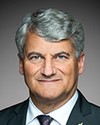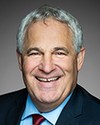I've checked your estimates.
Evidence of meeting #106 for Status of Women in the 42nd Parliament, 1st session. (The original version is on Parliament’s site, as are the minutes.) The winning word was data.
A recording is available from Parliament.
Evidence of meeting #106 for Status of Women in the 42nd Parliament, 1st session. (The original version is on Parliament’s site, as are the minutes.) The winning word was data.
A recording is available from Parliament.
Assistant Director, Social and Aboriginal Statistics Division, Statistics Canada
I've checked your estimates.
Conservative

Gérard Deltell Conservative Louis-Saint-Laurent, QC
Yes, and I will check myself, as well, the next time I speak.
Ladies, I would like to ask you two questions about the first table, which focuses on the representation of women in Canada.
As I was unfortunately a bit late to the meeting, I don't know whether you have already provided the information. In the table, it says 35% of legislators. Legislators are lawmakers. So they are members of provincial, territorial or federal parliaments.
Is that right?
Assistant Director, Social and Aboriginal Statistics Division, Statistics Canada
That's right.
Conservative

Gérard Deltell Conservative Louis-Saint-Laurent, QC
Great.
I assume that you also provided information for each province.
Assistant Director, Social and Aboriginal Statistics Division, Statistics Canada
We actually just provided a summary, but that data is available by province.
Conservative

Gérard Deltell Conservative Louis-Saint-Laurent, QC
Okay.
Do any provinces have an equal percentage of women and men?
To your knowledge, is there equity in any legislature in Canada?
Assistant Director, Social and Aboriginal Statistics Division, Statistics Canada
In any of the provinces, is there a province that has equity in the legislators?
Conservative
Chief, Social and Aboriginal Statistics Division, Statistics Canada
I didn't look at legislators, because the number of legislators in Canada was fairly small. No, I don't have that here. I have the number of legislators who took political science at school, but that's something different.
Conservative

Gérard Deltell Conservative Louis-Saint-Laurent, QC
Well, I don't want to start a debate on what is a “nation”, but in French you're talking about
people with a seat in Parliament
and in the English version you are talking about the national Parliament.
I don't want to put you in a predicament.
Assistant Director, Social and Aboriginal Statistics Division, Statistics Canada
It's true that there is a difference between the two.
It is noted.
Conservative
Assistant Director, Social and Aboriginal Statistics Division, Statistics Canada
We did not provide that document to the public. It was created only for this committee.
We are taking note of that.
Thank you.
Conservative

Gérard Deltell Conservative Louis-Saint-Laurent, QC
That's very good.
I just wanted to show that I read every word carefully.
Assistant Director, Social and Aboriginal Statistics Division, Statistics Canada
I really appreciate your attention.
Conservative

Gérard Deltell Conservative Louis-Saint-Laurent, QC
Let's now look at the statistical data.
As my colleague Ms. Harder said earlier, you cannot comment on the figures subjectively. I respect that, and I definitely don't want to put you in an awkward position.
However, when I look at all the figures, there isn't a lot of difference between men and women, with the exception of women who are “very interested” or “not at all interested”. When it comes to expressing views through a newspaper or a politician, the percentage of women is 9% and that of men is 11%. So that is not a significant difference.
I understand that, statistically speaking, if we are talking about 12% and 16%, there is a difference of four points, which is one-third. So it is 33% more. We are after all talking about 12% to 16%. That's my very personal and subjective understanding. In any case, I am paid to be subjective and you're not. I know that.
Have you done any similar analyses on trades, regardless which, where similar figures are found in terms of engagement?
Assistant Director, Social and Aboriginal Statistics Division, Statistics Canada
I'm not sure I understand your question, but I don't think we have any studies on that.
Conservative
Conservative

The Chair Conservative Karen Vecchio
There is no more time for you.
Thank you.
We're going to move to Marc Serré, for five minutes.
Liberal

Marc Serré Liberal Nickel Belt, ON
Thank you, Madam Chair.
I thank the witnesses for participating in this meeting.
Do you have any statistics that establish a parallel between women in politics in rural communities and those in urban communities?
Assistant Director, Social and Aboriginal Statistics Division, Statistics Canada
No.
Liberal
Assistant Director, Social and Aboriginal Statistics Division, Statistics Canada
In the census, we could look at the number of people who are outside of metropolitan regions. That would be an estimate.
Liberal

Marc Serré Liberal Nickel Belt, ON
Very well.
In the documents prepared by the analyst, it says that, in 2015, women represented “30.5% of band councillors on First Nations of Canada band councils”. That percentage is higher than in municipal, provincial and federal spheres.
Do you have an analysis that would explain the fact that the percentage of aboriginal women who are members of first nations band councils is so high?
Assistant Director, Social and Aboriginal Statistics Division, Statistics Canada
Aside from the census, Statistics Canada does not conduct surveys on first nations communities. We have the aboriginal peoples survey, but it focuses on first nations members living off-reserve, as well as the Métis and Inuit. Data from that survey will be available next fall.